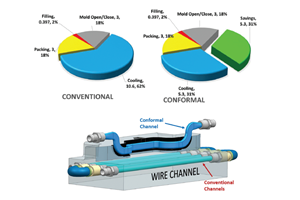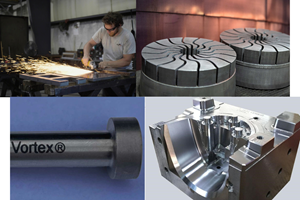Tooling Boards Offer Uniformity/Stability in Prototyping and Tooling Applications
A very uniform, dimensionally stable, urethane-based series of tooling boards has been developed for use in prototype, composite tooling, foundry pattern, fixture and other applications.
A very uniform, dimensionally stable, urethane-based series of tooling boards has been developed for use in prototype, composite tooling, foundry pattern, fixture and other applications and features fast, easy machining, excellent uniformity, superior edge definition, better chip formation, very fine surface structure, and ease of sanding.
Offered by Curbell Plastics, Inc. (Orchard Park, NY)—a supplier of modeling materials, plastic sheet, rod, tube, film, adhesives and sealants—Rampf® RAKU-TOOL® tooling boards are available in 13 grades in urethane and epoxy, including:
- Low density styling boards (10–29 pounds per cubic foot) for styling and design models for determination of fit and function.
- Medium density model boards (34–45 pounds per cubic foot) for models and patterns.
- High-density work boards (44–106 pounds per cubic foot) for jigs, fixtures, foundry patterns, core boxes and vacuum forming molds.
Features
According to Curbell Plastics Business Development Manager Rick Delaney, the tooling boards are suitable for a wide range of applications. “These boards are replacing mahogany, jelutong and pine because of their outstanding dimensional stability and lack of grain," he says.
These new grades were developed in response to moldmakers’/modelmakers’ requests for materials that allowed for fast feedrates in their CNC equipment and required minimal sanding afterwards. Also, the boards’ uniformity is especially appreciated by users who have been disappointed in the past by inferior urethane boards, which suffered from “voids” or bubbles, Delaney notes. “When machining opens up a void, this must be filled with repair paste, allowed to cure and then sanded,” he says. “This all takes time and can be a real problem when deadlines are tight.”
Applications
Rapid Prototyping/Rapid Manufacturing
“A CNC machining center is used to convert a CAD file to a 3D model using medium density urethane modeling board,” Delaney explains. “An RTV silicone mold can then be made from the modeling board model. At that point a urethane or epoxy casting resin can be used to create numerous replicas from the RTV silicone mold. This method is often used when required quantities are small—perhaps 100 or fewer.”
Composite Tooling
“As fiber-reinforced composites have grown in usage, so has the demand for tooling,” Delaney comments. “Wood has been widely used for the largest tools, due to cost. However, wood will not keep tight tolerances due to variations in moisture content. Also, some high-density woods traditionally used for mold and modelmaking—such as mahogany—have shown significant cost increases in recent years. For these reasons, many jobs have been switched from wood to urethane tooling boards. An added benefit is improved consistency.”
Thermoforming
“Thermoformers are switching from wood molds and plugs to Rampf modeling boards,” Delaney states. “Densities of 60
to 80 pounds per cubic foot are most commonly used. They are quickly and easily machined by hand or on CNC equip-ment and exhibit a fine surface with minimal sanding. Thermoforming molds require good heat resistance, edge strength and durability in order to maximize tool life. These tooling boards provide an excellent balance of performance and economy.”
Styling Models
“The boards' low densities allow for faster machining, easy handling of large volume models and excellent economy,” Delaney notes. “Styling models are sometimes very large, perhaps 200 or 300 cubic feet in volume. For models this large, cost and weight are key, thus the interest in very low densities.”
These tooling boards are a valuable material option for moldmakers, modelmakers and fixture makers—offering a unique balance of high performance and reasonable cost.
Related Content
How to Use Thermal Management to Improve Mold Cooling
A review of common mold cooling issues and possible solutions, including 3D printing applications.
Read MoreMold Materials, 3D Printing Technologies for Next-Gen Moldmaking
As moldmaking advances, so too do the materials and processes involved in their efficient production, including these latest mold materials and 3D printing technologies.
Read MorePrecision Meets Innovation at IMTS 2024
After attending IMTS, it's clear that the integration of advanced technologies is ready to enhance precision, efficiency and automation in mold manufacturing processes. It’s a massive event, so here’s a glimpse of what the MMT team experienced firsthand.
Read More3D Printing Enables Better Coolant Delivery in Milling Operations
Just like 3D printing enabled conformal cooling channels in molds, additive manufacturing is now being used to optimize coolant delivery in cutting tools.
Read MoreRead Next
How to Use Strategic Planning Tools, Data to Manage the Human Side of Business
Q&A with Marion Wells, MMT EAB member and founder of Human Asset Management.
Read MoreAre You a Moldmaker Considering 3D Printing? Consider the 3D Printing Workshop at NPE2024
Presentations will cover 3D printing for mold tooling, material innovation, product development, bridge production and full-scale, high-volume additive manufacturing.
Read More












.jpg;maxWidth=300;quality=90)







